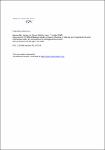Improvement of H5N1 influenza vaccine viruses: Influence of internal gene segments of avian and human origin on production and hemagglutinin content
Abt, Marion
Jonge, Jørgen de
Laue, Michael
Wolff, Thorsten
The H5N1-clade 1 influenza vaccine strain NIBRG-14 produces exceptionally low amounts of antigen, a problem recently encountered also for initial pandemic H1N1-2009 vaccine seeds. Here, we report on a strategy that may contribute to overcome this obstacle. Influenza vaccine viruses usually consist of two segments coding for the antigenic HA and NA proteins of a wild-type strain and the six residual internal gene segments of the vaccine donor strain A/PR/8/34 (PR8). To enhance the antigen yield from H5N1 vaccine virus we generated by reverse genetics a set of PR8-based reassortant viruses expressing the HA and NA segments of the prototypic strain A/Vietnam/1203/2004 and additional replacements of the internal M or PB1 genes of PR8. The reassortants were compared to the parental PR8 and H5N1 viruses in terms of growth in embryonated chicken eggs and the amount of incorporated antigenic HA protein. Compared to NIBRG-14, three out of six viruses displayed an increased replication in embryonated chicken eggs and higher HA content that was also maintained after ether/detergent extraction of virions. Electron microscopic analysis showed that the reassortment hardly affected particle shape and size. Two selected H5N1 reassortant viruses were investigated concerning their pathogenicity in ferrets and found to behave as low pathogenic as the PR8 donor strain. In conclusion, this study shows that replication and antigen content of PR8-derived H5N1 influenza vaccine viruses can be improved by incorporation of heterologous internal gene segments without compromising their attenuated character.
Dateien zu dieser Publikation
Keine Lizenzangabe

